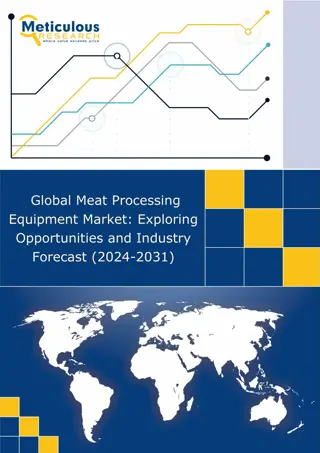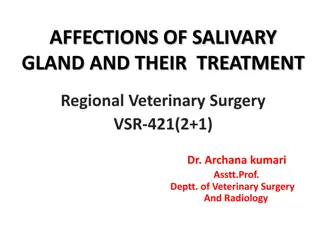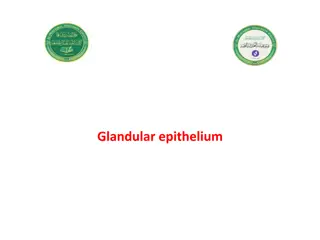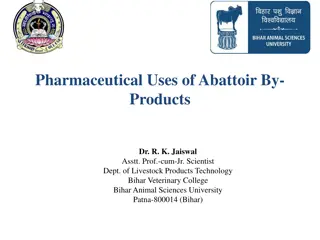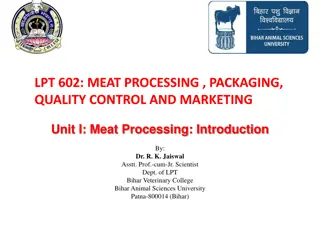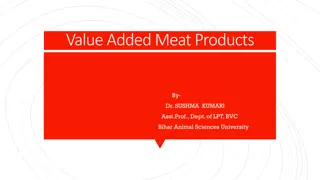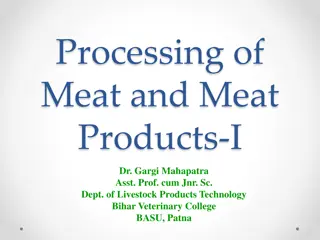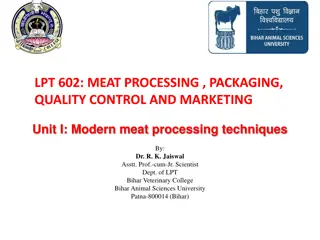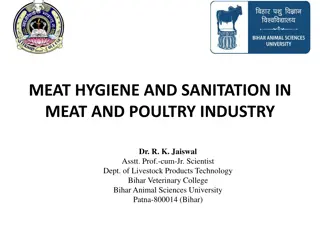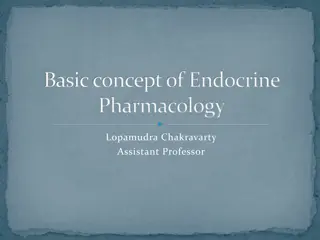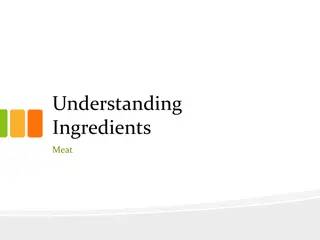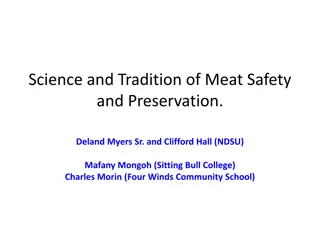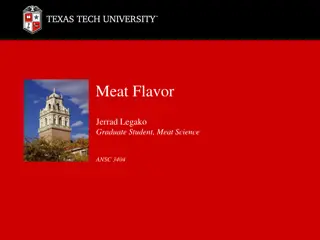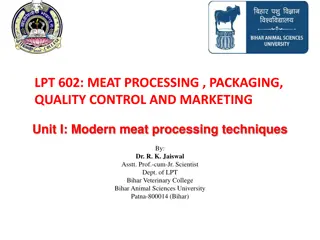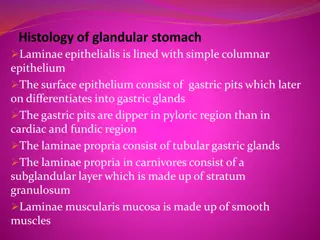Utilization of Glands and Biochemicals in Meat Science Research
Glands play a crucial role in meat science research, with various organs such as pancreas, adrenal glands, and parathyroid gland providing valuable biochemicals like insulin, thyroxine, and corticosteroids. The extraction methods and applications of these glands in food science and medicine are detailed, along with the utilization of other organs like stomach, pituitary gland, ovaries, testes, lungs, and liver. Additionally, the hide and skin of animals are discussed in terms of their utilization in leather and gelatin production.
Download Presentation

Please find below an Image/Link to download the presentation.
The content on the website is provided AS IS for your information and personal use only. It may not be sold, licensed, or shared on other websites without obtaining consent from the author.If you encounter any issues during the download, it is possible that the publisher has removed the file from their server.
You are allowed to download the files provided on this website for personal or commercial use, subject to the condition that they are used lawfully. All files are the property of their respective owners.
The content on the website is provided AS IS for your information and personal use only. It may not be sold, licensed, or shared on other websites without obtaining consent from the author.
E N D
Presentation Transcript
Meat Science (JRF) Part 3 By Dr. Gargi Mahapatra Asst. Prof. cum Jnr. Scientist Bihar Veterinary College B.A.S.U., Patna.
Utilization of Glands Glands should be excised from slaughtered animals with in 15-20 min. Glands are chilled in metal containers in direct contact with ice but avoid contact with water as principal agent may wash away. Clean glands quickly frozen to -20 to -18 C. Glands are packed individually and processed to acetone dried powder (A.D.P.), longer method of preservation Organ Remove Con. Tissue/ Immerse in 4 vol. of chilled Blood Vessel/Fat etc. Acetone for 3 hr. Ground Mince Tissue to fine treat with 3 vol. Cut into small pieces, 3 vol. powder chilled acetone of chilled acetone, 2-3 hr.
Glands & their Bio-chemicals Pancreas Thyroid Gland Acetone dried powder of this organ is used to extract Thyroxine using Barium Hydroxide. Yeild of thyroxine 0.08% Adrenal Glands Outer cortex & Inner Medulla Mainly Insulin ( cells) in addition Glucagon (? cells), trypsin, chymotripsin & amylase. 1 kg fresh bovine/pig pancreas yields 150 mg of crystalline insulin with activity 25 IU/mg of insulin. Parathyroid Gland Corticosteroids Adrenaline and Nor-adrenaline hormone Edision s Dis. (Hypo-coticosteroid Syn.) 0.2% Adrenaline Extraction of Parathormone. Used in the prevention of tetany and increase the rate of calcium excreation. Fresh Wt. or 1.0% Dry wt.
Stomach Pituitary Gland Rennet/Rennin Pepsin Anterior Lobe Posterior Lobe Unwashed Mucosal Abomasum of milk fed calf lining of hog stomach preserved in 1% H2SO4 or as A.D.P Growth hormone Oxytocin L.H. F.S.H. A.C.T.H. M.S.H. (Extracted in 2% Acetic acid; Milk ejection factor; Uterine contraction) Vasopressin (Vasoconstrictor; Anti-diuretic Hormone) Gall Bladder 1kg Bile- 6 Buffalo or 5 S/G gall bladder Golden greenish colour, pH 7.1 ; Sp. Grav- 1.025 Bile Powder - 6% Moist.
Contd. Ovaries: Mature ovaries with corpus luteum but no cysts. Extraction of estrogen and progesterone. Testes: Testosterone extracted. Hyaluronidase enzyme (Bull/Ram Testes) Lungs: Heparin extracted from lungs of cattle (commonly) Liver: Liver extracts; Yield 15% of raw wt. Indicative in case of anaemia. *Crude insulin purified by crystallization using zinc salts or picric acid. *Insulin recovered by insulin picrate by gel filtration.
Hides/Skin Utilization Hides Skin Large Animal Small Animals / Young Calves Yield- 7% of live wt. Yield- 11% of live wt. Wt. > 30 lbs/ 13.62 kg Slaughtered Ani. 20-25 % Slaughtered Ani. 80% Fallen Animals 75-80% Fallen Animals 20% Wt. < 20lbs/9.1 kg Skin of pig is known as rind. Fresh hides/skin a.k.a. green hides/skin. Flaying- Process of removal of skin. Destination of hide- Leather or Gelatin
Classification of Hides and Skin Hides branded on butt - Texas/Colorado Hide Unbranded Hides - Native Hides Flaying of Slaughtered Animals - Slaughtered Hides Flaying of Fallen Animals - Fallen/ Rendered/ Murrian Hides Flaying by highly skilled workers - Big Packers Hide Flaying by less skilled workers - Small Packers Hide Unborn Calf- Slunk Skin Immature Calf - Calf Skin - 9-15 lbs. wt. Calf Kip Skin - 15-25 lbs. wt. Heifer- Heifer Skin - 25-30 lbs. wt.
Contd Light Cow Hide (30-53 lbs.) Cow Cow Hide (>30lbs.) Heavy Cow Hide (>53 lbs.) Extreme Light Hide (32-48 lbs.) Light Steer Hide (48-58 lbs.) Heavy Steer Hide (> 58 lbs.) Steer Bull Bull Hide (60-100 lbs.)
Defects in Hide/Skin Post -mortem Defects Ante-mortem Defects 1. Bad Shape/ Pattern - Ground drying, Fallen hides etc. 2. Bad Flaying -Knife Cut 3. Curing Defect -Salt burns, improper application of salt 4. Smoke damage - Excessive exposure to smoke. Poor substance- Genetic Factor/ Species variation 2. Defects due to Disease - Pox, Mange, Dermatitis etc. 3. Grain Damage -Thorns or wire fence scratches, branding, abscess abrasion, tick damage, bacterial action 1.
Processing of Hides Hide/Skin Drying/ Curing Conditioning Tanning Post-Tanning Operations Leather (End/Final Product)
Conditioning of Hides Drying Techniques (7 days min.) Washing and Soaking Ground Drying Fleshing Suspension Drying (Frame Drying, Line Drying & Tent Drying) Liming and De-hairing Hide Curing Done immediately after flaying Washing and De-liming Batting ( vegetable tanning) Techniques Dry Salting Pickling( chrome tanning) Wet Salting
Important Points During dry salting hides kept flesh side up. 2-3 mm thick layer of fine salt applied. The weight of salt equal to weight of hide. These salted hides are then stacked on one another, to a max. height of stack 1m. Dry salting is practiced in rooms maintained at 15 C and 85-90% relative humidity. During wet salting a curing solution prepared (23 kg salt+ 62 kg water for 100 kg of hides). The hides are soaked in pits, 1.25m deep. Soaking times varies from 2 days for fleshed hides to 2 weeks for un-fleshed hides. The Brining liquid maintained at room temperature. Such hides retain 35% moisture.
Important Points Hides are soaked in zinc chloride+ soda ash+ borax solution. All proteins of blood and lymph removed and it rehydrates and restores its shape. During the liming process Hides soaked in saturated lime solution with 0.1% sodium sulphide. This is applied to loosen hair and epidermal cells. Hides washed with mild acid to neutralize the lime. During batting hides are treated with proteolytic enzymes at pH 8.5. Results in soft and pliable pelt. Such pelts tanned by vegetable tanning During pickling pelts are pickled in bath of 1% Sulphuric acid and 10% salt in water, maintained at a pH of 2-2.5 for 2-3 hrs. Such pelts are tanned by chrome tanning process.
Tanning (5-6 hrs) Vegetable Tanning Delimed pelts are immersed in natural tanning liquor of progressively stronger concentration. The tannin diffuses and imparts uniform colour Used for heavy leather articles like belts, saddle, harness etc. Tanning producing plants are Avaran ( Cassia auriculata), Babul (Acacia arabia), Myrabalan (Terminalia chebula) Konnan (Cassia fistula). Chrome Tanning A more modern, quicker and popular technique. Yields softer, stronger and supple leather. Types Single Bath Process- Chrome salts prepared in a solution and then applied on skin. The strength of the solution is then gradually increased Double Bath Process- Chemical interaction forming the chrome solution is practiced on skin itself.
Post tanning Operations 7. Glazing- Done in case of chrome tanning. Glass cylinders are rolled on the surface of the buffed leather. This process produces high luster on the grain surface 1. Setting out and Wiring- Hide passed between 2 large rollers. Removes excess tanning liquor and moisture 2. Splitting and Shaving- Practiced to adjust leather thickness 3. Dyeing- To produce desired color 4. Fat Liquoring- Lubrication with oil to adjust firmness. 5. Staking- Makes the leather more pliable. 6. Buffing- Smooth the grain surface of leather for better appearance. (Buffed Leather) **During double bath process sodium-bichromate is reacted with maltose and sulphuric acid to get chromic sulphates. Chromic sulphates are applied @ 1.5-2.0% at a pH of 2.5 , then increased to pH of 3.5.
Wool (Medulla is absent) Outer layer- Cuticle/ Cuticular cells Wool fibre Inner layer- Cortex/ Corticullar cells Basically it is protein called keratin, which is rich in sulphur. Wool sweat- Yolk/ Suint- Water Soluble Wool wax- Lanolin Washed by detergents Wool- Medulla absent Hair Medulla present Kemp- Medulla irregularly present Indian Breeds- Coarse wool- Carpet Quality-Annual yield 1- 1.5 kg of greasy wool. Indian wool- Canary colored- Bacterial action at high pH and low grease ( Ideal color- white/ creamy white).
Contd Shearing- Twice a year (Spring & Autumn), 1stshearing at 8 months age. Dagging- Shearing of soiled wool. Lox- Wool contaminated with feaces and urine. Animal washed 10-15 days before shearing. Animal off-feed 10 hours before shearing. Sampling size of fleece- 200 fibres are chosen randomly. Fine wool <6cm in length; Coarse wool >10cm in length. Impurities in wool: Max 20% Vegetable content in wool known as Burr: Low burr (3%) Medium burr (5%) and High Burr content (>5%) Burr is removed by acid treatment known as Carbonization.
Contd Neck area- Coarse and broader wool Shoulder area- Choice wool. Flank area- Very good wool. Leg area- Hair Pole- Kempy Belly area- Soiled poor quality kempy fibre- Skirting practiced to remove it. Thigh area- Kempy Back bone line- Poor quality fibre 1 inch below back bone line till flank- Good quality wool.
Pulled Wool Wool obtained from slaughtered animal METHODS Sweating- Controlled putrefaction of skin in damp chambers (20 C x 48 hrs.); follicles loosen up and wool is pulled out. Painting- Hair loosening agent (sodium sulphite) painted on pelt. Best technique. Liming- Immersion of pelt into lime water.
Important Points Crimps- Number of waves in a fiber. Approx. 2-12/cm; the more the better. Staple length- Length of fiber with crimps. Fiber Length- Length of stretched fiber without crimps. It is measured in hanks which is 1/12 of an inch. Fiber diameter measured in microns. Medullation percentage is measured by Projection microscope, Lanometre or Dichlorobenzene. Carpet wool has about 15% by count and 35% by wt. of medullated fibres. Wool is hygroscopic in nature: can absorb water which is 18-50% of its own wt. Wool can extend upto 70% of its original length before breaking.
Important Points Basal layer of epidermis crucial for wool development. Wool follicles appear in the second month of gestation. Primary follicles produce coarse wool whereas secondary follicles produce fine quality wool. The S:P ration dictates the fleece quality. Fine wool producing breeds S:P= 20:1 whereas coarse wool producing breeds S:P= 3:1 to 1:1. Mohair- Obtained from Angoora Goat, No medulla. Fur-A synonym of hair- Has medulla. Wool: Specific gravity 1.304 Wool: refractive index 1.553- 5.00. Detergent washing of greasy wool is known as scouring. This process removes wax.
Bristles Stiff hair of pigs, hog and boar. Area- Back, Neck & Tail. Production- China > India > Russia Live animals, bristles plucked. Superior lusture & resilience. Plucked twice a year. Dead/ Slaughtered animal- Pulled or Shaved after scalding. Colour- White bristles (only UP & Punjab); Black/ Darjeeling bristles (Darjeeling/ W.B.) and Grey bristles. White bristles more expensive than dark bristles. Wild boars- bristles of better length. Length of bristles: 44-159 mm (India 57-159 mm). Bristles over 121 mm length fetch good price. Short bristles < 44mm known as rifflings.
Bristles contd.. Thickness of bristles increases with length. Based on thickness bristles categorized to extra stiff bristles, stiff bristles and soft bristles. Dragging- Process of sorting bristles into grades of specific length. Bristles stacked butt side up. Each size tied up into 100 gm bundle of 2 inch diameter Kanpur is the biggest dressing center for bristles. Bristles sterilized by autoclave at 25-40 lbs X 1.5 hrs. The wet bristles are then dried in hot air oven at 60 C. Bristles quality, 19 grades and 11 Schedules based on Bristle Grading and Marketing Rules -1969 & Bristle Grading and Marketing Rules (Amendment) -1973
Organic Wastes Biogas-Anaerobic fermentation of feaces, urine and slaughter house waste products. Contains 60% CH4, 30% CO2 and traces of H, CO etc. (Impure CH4- 93% air and 7% CH4) Compost-Aerobic fermentation of feaces, urine and slaughter house waste products. Made in 90 days. Used as manure for soil. Paunch- Liquid and solid fractions separated by pressing. Liquid fraction concentrated to be used in pig feed whereas fibrous fraction used as fuel. Paunch Production- 27 kg Cattle; 2.7 kg Sheep and 1.7 kg lamb.




